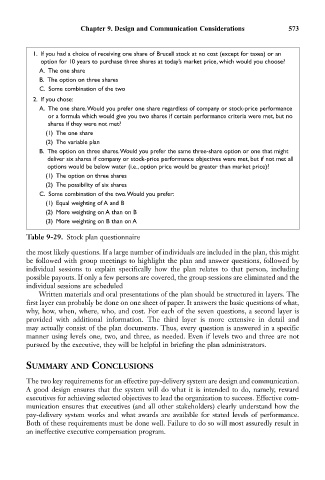Page 587 - Bruce Ellig - The Complete Guide to Executive Compensation (2007)
P. 587
Chapter 9. Design and Communication Considerations 573
1. If you had a choice of receiving one share of Brucell stock at no cost (except for taxes) or an
option for 10 years to purchase three shares at today’s market price, which would you choose?
A. The one share
B. The option on three shares
C. Some combination of the two
2. If you chose:
A. The one share.Would you prefer one share regardless of company or stock-price performance
or a formula which would give you two shares if certain performance criteria were met, but no
shares if they were not met?
(1) The one share
(2) The variable plan
B. The option on three shares.Would you prefer the same three-share option or one that might
deliver six shares if company or stock-price performance objectives were met, but if not met all
options would be below water (i.e., option price would be greater than market price)?
(1) The option on three shares
(2) The possibility of six shares
C. Some combination of the two.Would you prefer:
(1) Equal weighting of A and B
(2) More weighting on A than on B
(3) More weighting on B than on A
Table 9-29. Stock plan questionnaire
the most likely questions. If a large number of individuals are included in the plan, this might
be followed with group meetings to highlight the plan and answer questions, followed by
individual sessions to explain specifically how the plan relates to that person, including
possible payouts. If only a few persons are covered, the group sessions are eliminated and the
individual sessions are scheduled
Written materials and oral presentations of the plan should be structured in layers. The
first layer can probably be done on one sheet of paper. It answers the basic questions of what,
why, how, when, where, who, and cost. For each of the seven questions, a second layer is
provided with additional information. The third layer is more extensive in detail and
may actually consist of the plan documents. Thus, every question is answered in a specific
manner using levels one, two, and three, as needed. Even if levels two and three are not
pursued by the executive, they will be helpful in briefing the plan administrators.
SUMMARY AND CONCLUSIONS
The two key requirements for an effective pay-delivery system are design and communication.
A good design ensures that the system will do what it is intended to do, namely, reward
executives for achieving selected objectives to lead the organization to success. Effective com-
munication ensures that executives (and all other stakeholders) clearly understand how the
pay-delivery system works and what awards are available for stated levels of performance.
Both of these requirements must be done well. Failure to do so will most assuredly result in
an ineffective executive compensation program.

